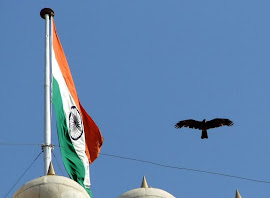Naxal Network Expanding Reach
The expanding reach of Naxals in India is evident, even as Governments at the state and centre grapple emerging problems of security, law and order and communal strife each day. Chhattisgarh saw Maoists carry out an IED attack killing a Deputy Superintendent of Police and three others, on the day of the visit of President Pratibha Patil. In another attack three CRPF personnel and a policeman were killed and six injured in a landmine blast triggered by the Maoists in Balrampur district bordering Jharkhand. Police personnel were recently suspended for not reporting for duty in Maoist affected Bastar area of Chattisgarh. A Union Home ministry report indicates that Left-wing extremists are spreading their presence to as many as 22 states with Maoists approaching banned groups like LTTE and ULFA for arms procurement. The aim of Naxalism as per Union Home Ministry is to liberate 35 percent of the territory by end of 2009. There are 39 groups operating in the country with armed cadres active in 15 states. There are 20,000 underground Maoist activists in the country and nearly 50,000 over ground members, more than a lakh Naxal sympathizers and supporters working in various frontal organizations.Naxalites have, of late, come out in strong support of the banned outfit Students Islamic Movement of India (SIMI). CPM spokesperson Azad third in the hierarchy of the central committee — in the statement said: “On the 23rd of August, our People’s Liberation Guerrilla Army (PLGA) had carried out a daring attack on the ashram of the most notorious Hindu fascist leader of Orissa, Lakshmananda Saraswati, who called himself a swami but is actually a Satan.” Militant groups are known to frequently make common cause though ideologically they may have different aims and notions. Thus the support by the Maoists to SIMI is natural. The Maoists have also supported the Kashmiri cause and therefore it appears that there is a general coalition building up against the Indian state. 21 groups are reportedly involved in the Singur agitation with many as the People’s Secular Democratic Front. The physical manifestation of this is still not clear and there is a need to ensure that measures taken to counter the same address the possibility of the terrorists uniting on an anti state cause.
While so far there has been no overt link between the Maoists and the ISI, the vocal support that Maoists have given to the SIMI and to the separatists in Kashmir needs to be analysed and any linkages to the ubiquitous ISI exposed. It is quite expected of an external intelligence agency to dabble in internal issues of a country, but it is up to the Indian security establishment to ensure that the links are discovered and effectively targeted.
The networked nature of militancy in the country is only now becoming evident to security and intelligence apparatus. There was limited appreciation of threats emanating from large number of divisive elements who are having commonality only in terms of opposition to the state and have a totally different ideology. Thus groups of different ideologies but common support mechanisms such as financial, arms and information networks have been working in tandem.
On the contrary states follow a standard hierarchical approach. Generally a new government which comes to power offers talks with the rebels. The same approach has been adopted by the new Chief Minister who very well knows that even if talks are offered, the rebels are not likely to come to the table given that they are holding sway in many tribal and forested areas in the state. More over it is also evident that UPA government has now adopted a policy of not having talks separately with Naxals by any states.
The problem in Jharkhand as per Human rights activist, Gladson Dungdung is of Adivasis and Moolvasis who have not been benefited by modern development and industrialization. The pace of development in the state of Jharkhand which has very poor administration and governance structures needs some consideration. There have been no major efforts in improving the method of delivery of governance to the masses in these areas, thereby providing the Naxal enough issues to wage their wars. More over land and tribal rights are also major issues which have remained unaddressed for long by many political parties over the years. All these factors add to the sustenance of militancy in these areas over a period.
The Malkangiri district in Orissa is becoming a key area of Naxal influence with dense forests and hilly tracts connected by a very poor road network. The tough terrain can be seen by River Sileru separates which separates it from Andhra Pradesh while River Saberi splits it from Chhattisgarh. ''It is really getting difficult on our part to complete the developmental work, especially that which can harm the interests of the Naxals like roads, bridges, culverts and all," said Nitin B Jawle, Collector, Malkangiri. 280 incidents of Naxal violence in the state since 1991, 120 have taken place here. In these tribal villages there is no mobile connectivity, no road, no telephone, no electricity and no familiar signs of authority providing the Naxals ideal environment for extending their influence.
Naxals are increasingly targeting children in their early teens as there are many youth who are disgruntled in Indian country side who fall prey to Naxal designs. While it is not possible to eliminate all grievances as roots of dissatisfaction touch as much the family as society, there have to be measures undertaken to ensure that lack of social security does not lead to societal insecurity and for this purpose expansion of the social security base and diversification of sources through which relief can be provided to the large number of needy in the country needs some consideration.
A COBRA force is being set up at a cost of Rs 1,389.47 crore out of which Rs 898.12 crore will be spent on land and infrastructure while Rs 491.35 crore will be used for manpower training over a period of three years. Two COBRA battalions will be raised in 2008-09, 4 in 2009-10 and another 2 in the ensuing year. Chhattisgarh will get three battalions (nearly 3000 personnel), Jharkhand and Uttar Pradesh will get two each and Orissa, Maharashtra and Bihar will get one battalion each of the new force. Andhra Pradesh already has a well knit counter Naxal force, the Grey Hounds. The Central government has prepared Rs 800-crore package for enhancement of capability for anti Naxal operations. States affected with Left-wing extremism are also likely to get special infrastructure projects. It is quite apparent that the government is planning an expenditure driven approach to tackle the Naxal issue without addressing the underlying problems of land reform and equity of rights to tribal and the marginal farming communities in the affected states. Till these issues are addressed the Maoists will continue to obtain support from the population and have sufficient basis for rebellion in the days ahead.
.jpg)








.jpg)

1 comments:
naxal is equally serious problem as global terrorism...nice post nishu
Post a Comment